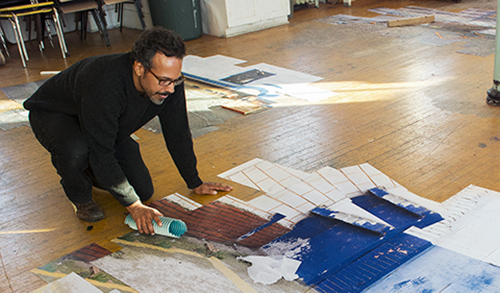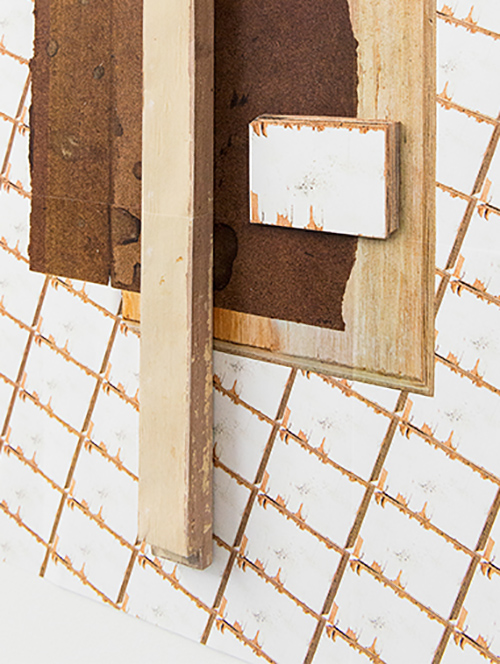Anamorphosis is showing at Bridge Productions in Seattle, September 7 – October 1. The opening is Wednesday, September 7, 6-9 pm, Bridge Productions, Hamilton Work Studios, 2nd Floor, 6007 12th Ave S, Seattle.
x
Anamorphosis is an ancient representational technique; you deform the image of the object so that from a certain angle it looks like one thing and from another angle a different image appears (sort of). A classic example is Hans Holbein the Younger’s painting The Ambassadors, with its anamorphic skull. In that instance, the technique is allegorical, a reminder that we will all die. For Dave Kennedy, the technique is also allegorical, but in this case it’s a reminder that things are not what they seem, identity is unstable, even untrustworthy. He uses photos, photocopies, bits of cast off material, explodes and reconstructs images of what conventionally are not aesthetic objects, dingy street scenes, junk lumber. So not only is Kennedy calling identity into question, he is also subverting the idea of a conventional aesthetic and the relative value of objects in our society, a subversion that, yes, extends to our identities as people (think: race, ethnicity, social class).
In his artist’s statement, he writes:
He [Kennedy] creates an augmented reality based on his surroundings, documenting various street scenes, walls, fences, detritus, and everyday objects; shooting nearly hundreds of images of the subject matter. They are recreated by tiling the image, printing them out on 8 x 11 or 11 x 17 copy paper, and stitching the individual ‘pixels’ together to form a large-scale print with jagged borders, or an assemblage of an exploded view much like a photographic blueprint. He then opts to affix an actual or facsimile object from the scene to the printed piece, further thwarting our ability to gauge what is ‘real’ versus ‘image’.
One that lends significance to places, objects, and things, elevating them through a process of familiarity. The details noticed become representations of reality. They represent both what they are and something else, at the same time. Such symbols allow for a different way of seeing the self, not as a mirror but as an access point. They act as elements that allow the viewer to explore and possibly complicate the narratives that are firmly affixed in normative presumptions.
This special manner of viewing, human subjectivities and more individualized identifications are seen as something that can become knowable. Anamorphosis is a metaphor for reimagining and expanding on appearances, as well as, overcoming “Otherness”— more in the sense that when someone is seen as less than, or as an object, this perspective can then be appropriated and re-loaded with more poignant meanings that point towards agency and autonomy.
As happens now and then on NC, Kennedy’s statement provoked a conversation (via email), which is really worth reprinting here.
DG: Let me ask you a couple of questions. When you say “less regarded spaces and objects”, what do you mean? And what drew you to such spaces and objects. As I see them, they are the objects and spaces that we pass over in life as unartistic, not aesthetic subjects. It’s kind of a rebellion against an unconsciously accepted conventional aesthetic, to render the “unaesthetic” aesthetic with your art and thus in an extended sense to reshape identity.
One of the guiding stars at NC is the Russian Formalist Viktor Shklovsky who said that the purpose of art was to take the ordinary, the things we pass over in the process of conventional seeing, and process them (make the “strange”) by representing them inside aesthetic form (techniques and structure). His idea was to slow down perception, which has become too conventional. We don’t actually see things anymore.
Dave Kennedy: On “less regarded spaces and objects”: Douglas, what you wrote about objects, spaces, aesthetics and rebellion.. rendering the “unaesthetic” aesthetic to reshape identity is both beautiful, concise, and exactly what I’m pointing to. I would love it if you included this. In addition, here’s how I got to this…
I grew up in a WWII housing project in the Pacific Northwest. Due to a lack of government funding various parts of my neighborhood were left in a constant state of disrepair. “Under Construction” each street block seemed to have many ethnicities represented which was accompanied by a lot of racism bred of misunderstanding. Personally, my mother is Italian and Eritrean, and my father Native American. So I didn’t look like one ethnic group or another and I would walk these multicultural city blocks alone, looking for someone else like me. It was common for people to make assumptions of what I was: Mexican, Samoan, Black. “What are you?!” My response to these objectifying guesses and questions is embedded in my practice and my exploration of an expanded view into unseen subjectivities.
Growing up in these spaces where other people did not want me to be. Places in various states of repair and ruin, provided me with a playground where I could escape this bias and bigotry. Lately I’ve been returning to these memories and attempting to reveal the marvelous that is often hidden in the aspects of life that we find quite ordinary while extending the availability of alternate roles to the subjects, places and objects I am finding.
On “reshaping identity”: First, thank you. It’s quite a distinction to be “fitting in” with Viktor Shklovsky… Andrei Tarkovsky once wrote: “The goal for all art – is to explain to the artist himself and to those around him what [a human] lives for, what is the meaning of [their] existence. To explain to people the reason for their appearance on this planet; or if not to explain, at least to pose the question.”
The action of deconstructing spaces and objects — these images, with my camera and then adhering the tiled photo copy sections back together feels like a performance of investigation that culminates in a space for meditation. The photocopy allows me to physically take apart the image and put it back together. I do this in part because I believe that social constructs are stories that can be taken apart and told differently.
We need an alternative definition of reality. One that allows us to reconsider the beliefs that we bring to what we see.
The details that I notice become representations of my reality. They represent both what they are and something else, at the same time. Such symbols, in my opinion, allow for a different way of seeing the self, not as a mirror but as an access point. They act as elements that allow the viewer to explore and possibly complicate the narratives that are firmly affixed in normative presumptions.
Within my process — this special manner of viewing, human subjectivities and more individualized identifications are seen as something that can become knowable. Anamorphosis is a metaphor for reimagining and expanding on appearances and overcoming “Otherness”— more in the sense that when someone is seen as less than, or as an object, this perspective can then be appropriated and re-loaded with more poignant meanings that point towards agency and autonomy.
—dg & Dave Kennedy
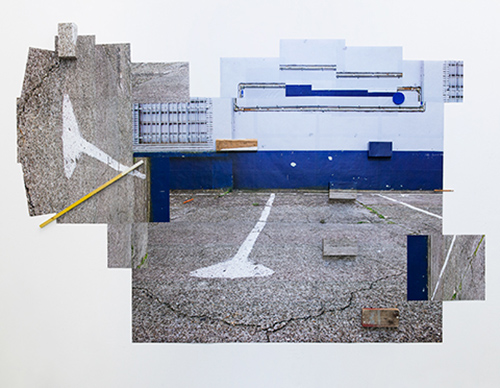 Something fully itself
Something fully itself
(photocopies, yellow stick, orange straw, wood scrap, pencil, brick, adhesive mound and blue cap. 108″ x 81″)
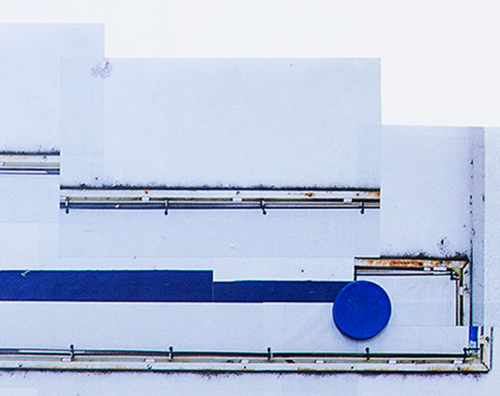 Something fully itself (detail 1)
Something fully itself (detail 1)
 Something fully itself (detail 2)
Something fully itself (detail 2)
x
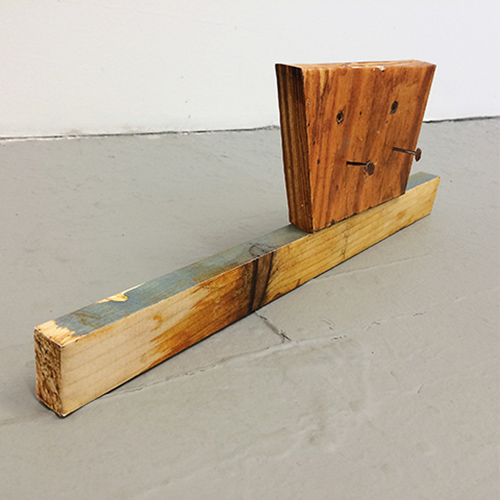 Dusty teal stick and Trapezoid (constructed photocopies of various dimensions)
Dusty teal stick and Trapezoid (constructed photocopies of various dimensions)
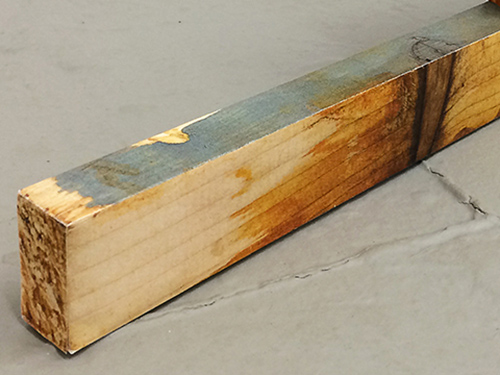 Dusty teal stick and Trapezoid (detail 1)
Dusty teal stick and Trapezoid (detail 1)
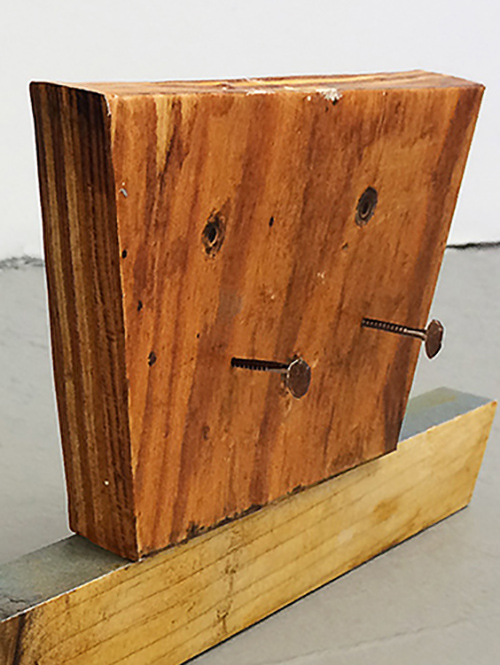 Dusty teal stick and Trapezoid (detail 2)
Dusty teal stick and Trapezoid (detail 2)
x
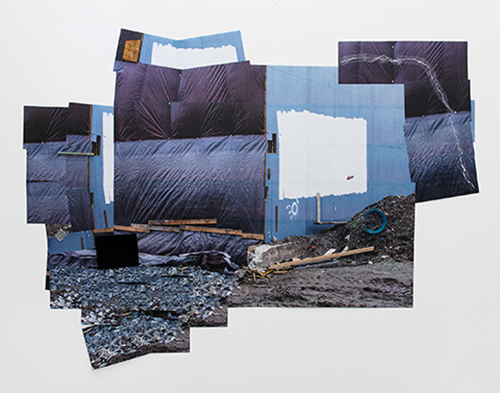 Framed between two others
Framed between two others
(photocopies, wood scraps, duct tape, tape, light grey tube, blue cap and rusty clip. 113″ x 73″)
 Framed between two others (detail 1)
Framed between two others (detail 1)
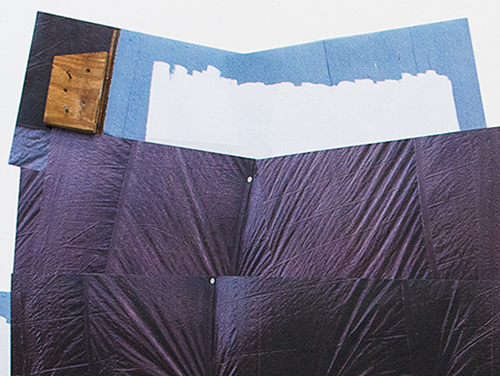 Framed between two others (detail 2)
Framed between two others (detail 2)
x
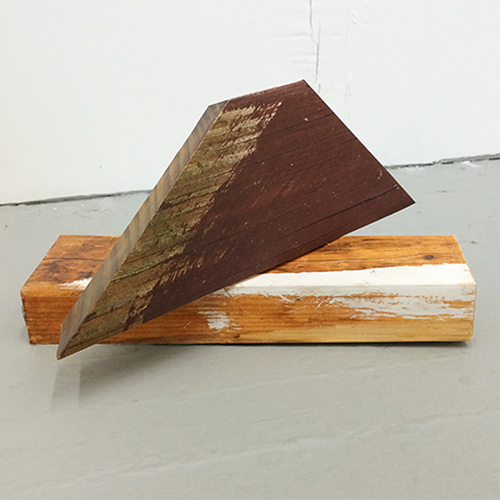 Burgundy and White stripe (Constructed photocopies of various dimensions)
Burgundy and White stripe (Constructed photocopies of various dimensions)
 Burgundy and White stripe (detail)
Burgundy and White stripe (detail)
x
 Almond Fudge Supreme (Constructed photocopies. 28″ x 40″)
Almond Fudge Supreme (Constructed photocopies. 28″ x 40″)
x
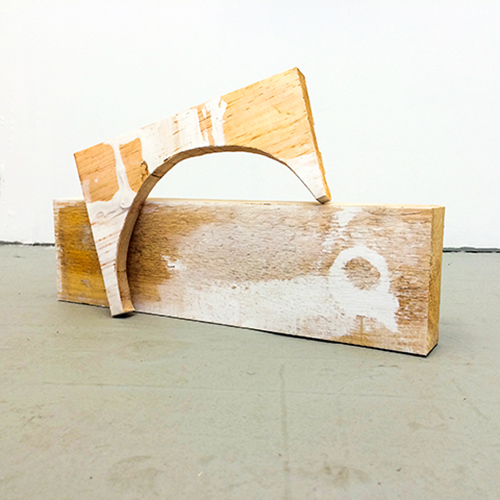 Crescent moon and white circle on rectangle
Crescent moon and white circle on rectangle
(Constructed photocopies of various dimensions)
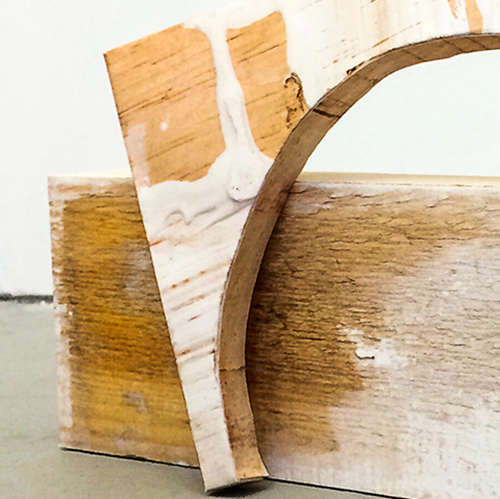 Crescent moon and white circle on rectangle (detail)
Crescent moon and white circle on rectangle (detail)
x
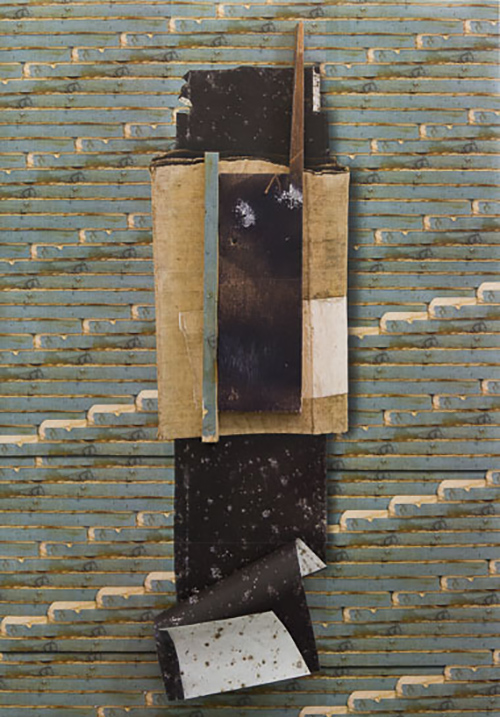 Black Raspberry delight (Constructed photocopies. 28″ x 40″)
Black Raspberry delight (Constructed photocopies. 28″ x 40″)
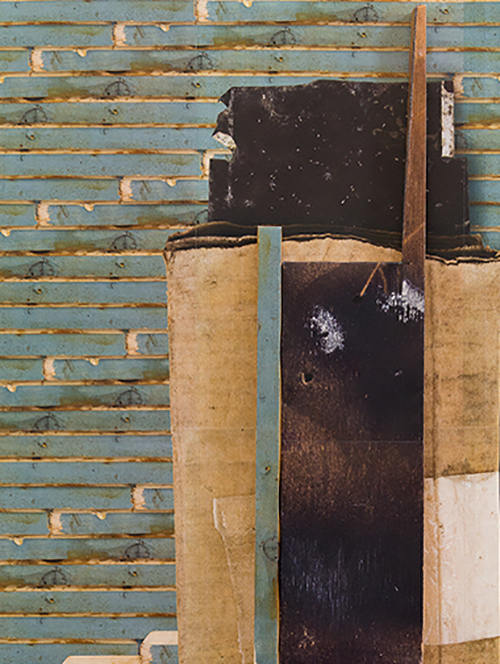 Black Raspberry delight (detail 1)
Black Raspberry delight (detail 1)
 Black Raspberry delight (detail 2)
Black Raspberry delight (detail 2)
Seattle WA 98108
x
x
 Dave Kennedy at Kinnear Space (The likeliness of an appearance)
Dave Kennedy at Kinnear Space (The likeliness of an appearance)
Photos: Courtesy of Joe Freeman www.joefreemanjunior.com
Dave Kennedy has recently worked as Co-Director and Visiting Lecturer for the University of Washington’s Art in Spain program. He is a recipient of the 4Culture Individual Project Award, as well as Artist Trust’s Grants for Artists Projects, the Joanne Bailey Wilson Endowed Scholarship, and the Vermont Studio Center Fellowship. Kennedy has recently served on Seattle Art Museum’s Blueprint Roundtable panel and has participated as a guest lecturer at the Henry as an intro to their “Out [O] Fashion” Show curated by Deb Willis. He has prepared multimedia presentations for the Society of Photographic Educators, Cornish College of the Arts, and the University of Washington on topics of marginalization and objectification. He received his MFA from the University of Washington in Interdisciplinary Arts and an undergraduate degree from Western Washington University in Visual Communication. Kennedy is currently working as the Visual Arts Coordinator at the Vermont Studio Center while continuing to be an active member of Photo Center Northwest and COCA in Seattle, WA. His works have exhibited both locally and internationally at such venues as the GGibson Gallery, Photo Center Northwest, Zhou B Art Center, Chicago Industrial Arts & Design Center, Escuela de Belle Arte in Spain, and the Seattle Art Museum’s Gallery.
Artist site: www.davekennedyimages.com
x
